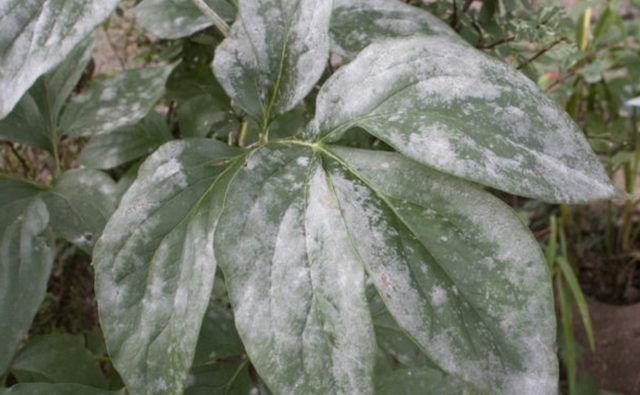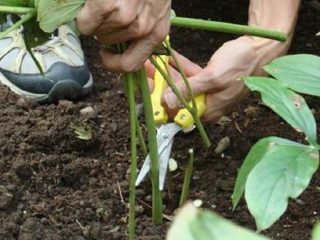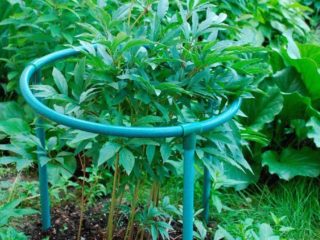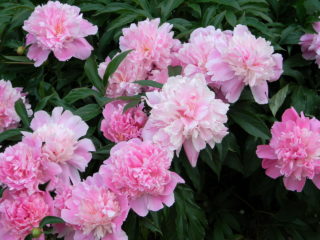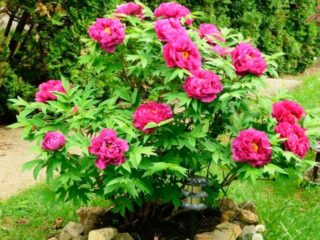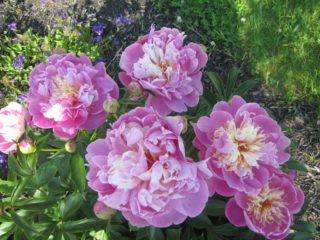Content
Peony Nancy Nora is one of the representatives of herbaceous milky-flowered species of culture. The variety was bred in the middle of the last century in the United States. But it still has not lost its relevance and is able to compete with new species. This is due to its high decorative qualities, lush and long flowering, as well as undemanding care.
Description of peony Nancy Nora
This type of peony is characterized by tall, spreading bushes. The height and width of the plant reaches 90 cm-1 m. The peony "Nancy Nora" has erect, strong shoots that easily withstand the load during flowering and do not bend even after rain.
The leaves of the peony "Nancy Nora" are trifoliate up to 30 cm long. The plates are alternately located on the stems. Their color is dark green. Due to the foliage, the peony bush looks voluminous. Peony "Nancy Nora", subject to the rules of care, retains its decorative effect throughout the season. And with the arrival of autumn, its foliage and shoots acquire a crimson tide.
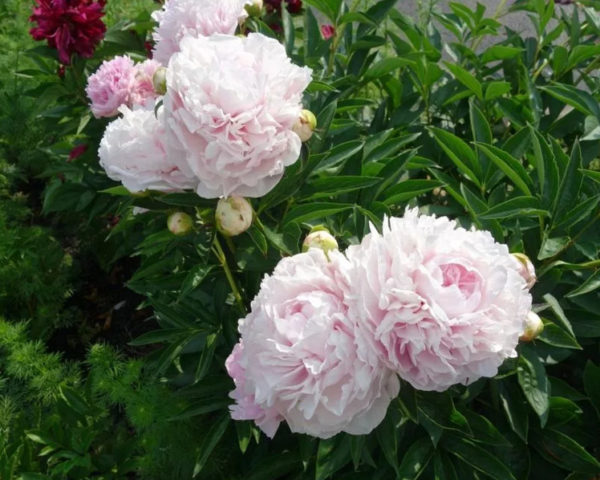
The peony is grown in gardens as an ornamental plant
This perennial forms a powerful root system, which deepens to 1 m and grows in width by 30-35 cm. Thanks to this, an adult peony bush is able to easily endure frosts and provide itself with moisture even in the driest periods of the year. At the top of the root are renewal buds, from which new shoots grow every spring.
The peony variety "Nancy Nora" is distinguished by its high frost resistance. It easily withstands low temperatures down to -40 degrees. It is recommended to grow in the central and northern regions.
Peony "Nancy Nora" belongs to the category of light-loving crops, but if necessary, it can withstand light partial shade. However, in this case, flowering will be 2 weeks late. The bush grows in 3 years.
Flowering features
Peony cultivar "Nancy Nora" belongs to the herbaceous milky-flowered crop species. It is characterized by large double flowers, the diameter of which varies from 18 to 20 cm. The shade of the petals is pinkish-milky with a pearlescent tint.
Nancy Nora has a medium flowering period. The first buds open in mid-June. The flowering period is 2.5 weeks.
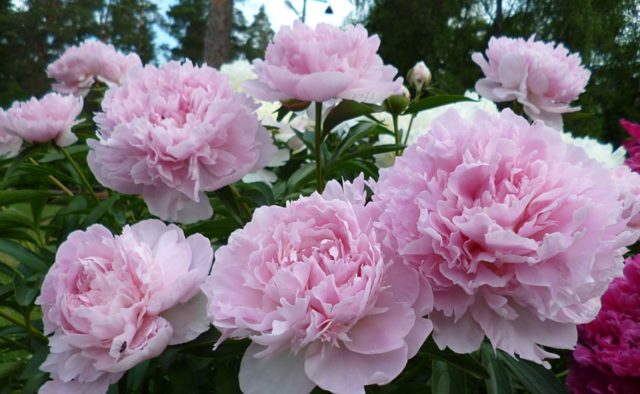
The splendor of flowering depends on the age of the bush and its placement on the site
With a lack of light, the plant actively grows foliage, but the number of buds is sharply reduced. The first full bloom occurs in the third year after planting in a permanent place.
Application in design
Peony "Nancy Nora" looks great both in singles and group compositions. It can be used to decorate the garden path, enter the gazebo, as well as decorate flower beds and create ridges.
Lilies, tall conifers and other decorative deciduous shrubs can become a background for a peony. Also, this plant will look organic in combination with a green lawn.
Ideal neighbors for the peony "Nancy Nora" can be:
- daffodils;
- tulips;
- hyacinths;
- irises;
- garden geranium;
- roses;
- daylilies;
- delphinium;
- geychera;
- flowering annuals.
You cannot plant a plant next to a hellebore, anemone, lumbago, adonis, as they emit toxic substances that inhibit the growth of a peony. Also, the culture does not like limited space, so planting in a pot can cause its death.
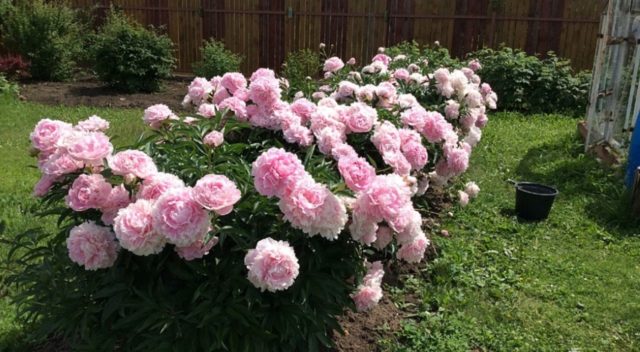
"Nancy Nora" is not suitable as a tub plant, as it has a powerful root system
Reproduction methods
Peony "Nancy Nora" can be propagated by cuttings and dividing the bush. Both methods help to obtain young seedlings with the preservation of all species qualities.
In the first case, in July, it is necessary to separate a stalk with a small root process and one dormant bud at the base from the bush. In this case, the shoot itself should be shortened to 2-3 leaves. It is necessary to plant cuttings in the garden bed in partial shade, without covering them with a cap. You just need to make sure that the soil is constantly wet.
In the second case, seedlings can be obtained by dividing the peony mother bush into parts. A plant from 5-6 years old is suitable for this. Moreover, he must have at least 7 developed shoots.
It is best to carry out this procedure in late August and early September. To do this, you need to dig out a bush, shake off the soil and wash the roots. Then put the plant in the shade for 2 hours to soften slightly. This will allow fission to be carried out with minimal loss. After the lapse of time, with a sharp knife, divide the peony bush into parts, each of which should have several root shoots and 3 renewal buds, as well as 2 or more shoots. Fresh cuts must be sprinkled with ash or charcoal, and then the seedlings must be planted in a permanent place.
Landing rules
You can plant the plant in April and throughout September, but the temperature should not drop below +2 degrees. Before planting the peony "Nancy Nora", it is necessary to prepare the site 2 weeks in advance so that the soil has time to settle. To do this, you need to dig it to the depth of a shovel and carefully select the roots of perennial weeds.
The Nancy Nora peony planting pit should be 60 cm wide and deep. Broken brick should be laid on the bottom with a layer of 10 cm, and the rest of the space should be filled with a nutrient mixture of turf, peat, humus and sand in a ratio of 2: 1: 1: 1.
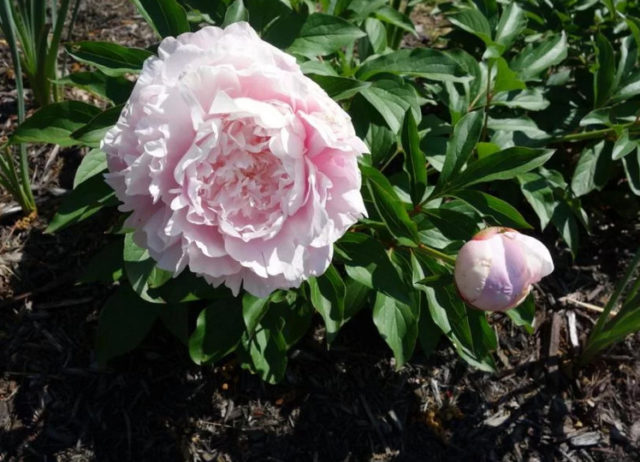
If the soil is acidic, it is necessary to add bone meal, superphosphate or wood ash
Landing Algorithm:
- Place a peony seedling in the center of the planting pit.
- Spread the roots.
- Lower it so that the renewal buds are 2-3 cm lower from the soil surface.
- Cover the roots with earth, compact the surface.
- Water abundantly.
Follow-up care
Peony "Nancy Nora" is not picky about care, but in order for the seedling to quickly take root and grow, it is necessary to control the moisture content of the soil. Do not overflow and dry out the roots. Therefore, in the absence of rain, it is recommended to moisten the soil 1-2 times a week.
It is also important to loosen the soil at the base of the bush. This improves air access to the roots. And so that a crust does not form on top of the soil, you can put mulch from peat or humus in a layer of 3 cm. This also helps prevent excessive evaporation of moisture during hot periods.
You need to start feeding the peony "Nancy Nora" from the third year. Until this period, the plant will have enough nutrients that were laid down during planting. The first time to fertilize is necessary in the spring during the period of active growth of shoots and the formation of a bush. During this time, you can use mullein (1:10) or bird droppings (1:15). If not, you can use urea or ammonium nitrate in a proportion of 30 g per bucket of water.
The second time feeding the peony should be carried out during the formation of the buds. During this period, mineral fertilizers such as superphosphate (40 g per 10 l) and potassium sulphide (3 g per 10 l) should be used.
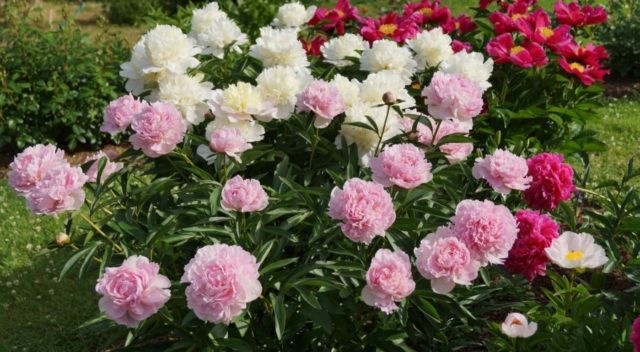
Peony feeding should be done after rain or watering, so that fertilizers do not burn the roots.
Preparing for winter
In late autumn, peony shoots should be cut off at the base, leaving small stumps. It is also recommended to cover the root with a layer of humus 10 cm thick. This will allow the plant to painlessly survive frosts even in the absence of sufficient snow.
Pests and diseases
Peony "Nancy Nora" has a stable immunity to many diseases and pests. But if the growing conditions do not match, the plant weakens.
Possible problems:
- Powdery mildew... The disease develops in high humidity and high temperatures. It manifests itself as white spots on the leaves, which subsequently grow and merge into one whole. As a result, they take on a dirty gray color. The disease interferes with the process of photosynthesis, as a result of which the leaves cannot function normally and wither. It is recommended to use "Topaz" or "Speed" for treatment.
- Ants... These insects attack the plant during the period of bud formation, which leads to their deformation. To fight ants, you must use a garlic infusion at the rate of 10 cloves per 1 liter of water. The mixture must be insisted for a day, and then spray the buds.
Conclusion
Peony Nancy Nora attracts attention from a distance. Its huge double flowers will not leave anyone indifferent. Therefore, this variety maintains a leading position for many years. And unpretentious care makes it popular among experienced and novice gardeners.
Reviews of the peony Nancy Nora
https://www.youtube.com/watch?v=Fv00PvA8uzU
